

여러분의 건강을 지키는 제1파수꾼 영상의학
그 영상의학분야의 중심에 휴먼영상의학센터가 있습니다.
전세계에 발간되는 VISIONS 매거진에 휴먼영상의학센터 정혜두 원장님이 소개되었습니다.
VISIONS 매거진은 CT, MRI, X-Ray, Ultrasound 분야의 진단 이미징, 임상 환경의 최신 개발 내용을 담는 잡지입니다.
잡지에 게재된 내용은 전립선비대증 비수술 치료방법인 전립선동맥 색전술입니다. 전립선동맥 색전술은 국소마취와 미세침습으로 혈관 내로 접근해 전립선비대증을 치료하는 시술로 수술과 달리 합병증이 적고 회복이 빨라 여러모로 환자에게 유리한 치료법입니다.
휴먼영상의학센터의 전립선동맥 색전술 경험은 국내를 넘어 세계 수준의 케이스와 더불어 높은 성공률을 보입니다.
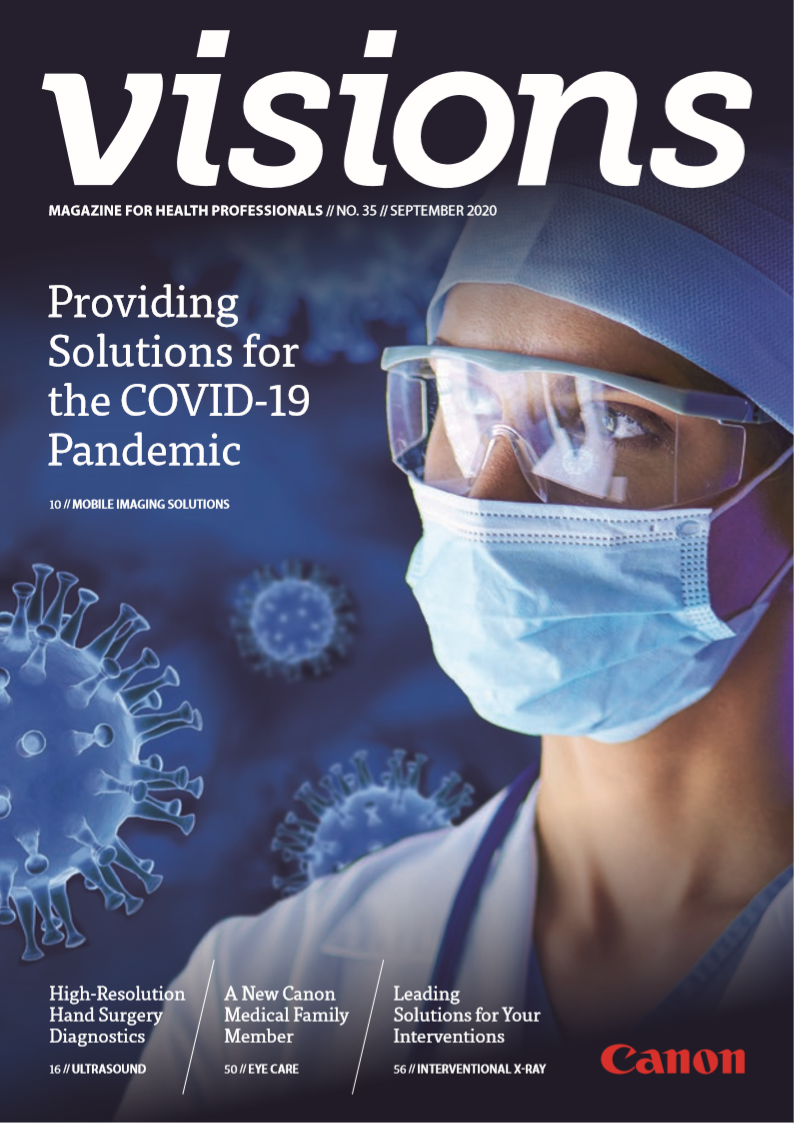
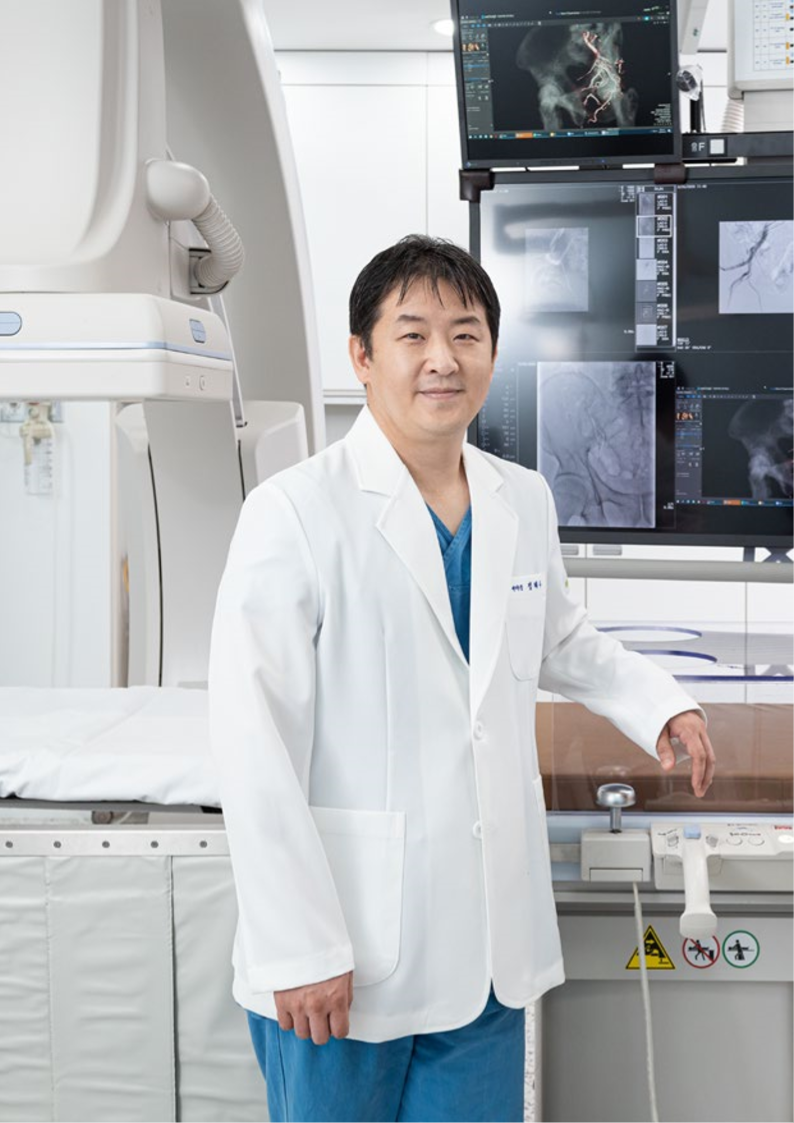
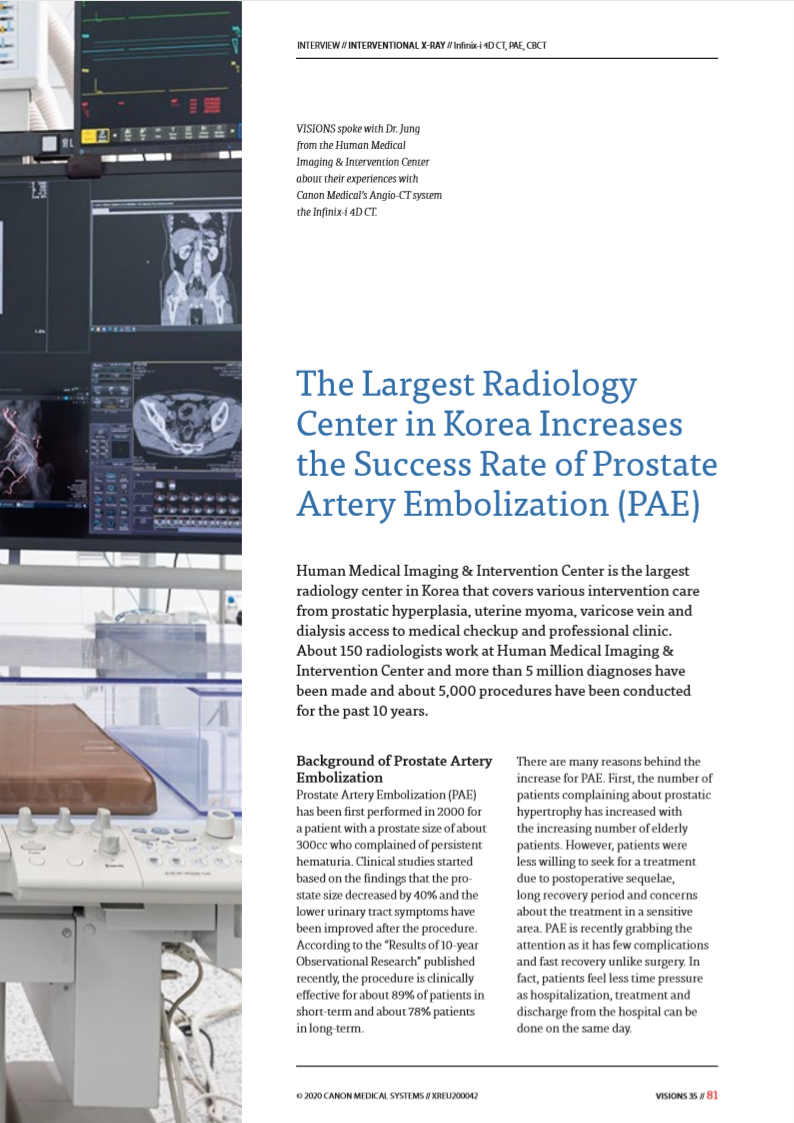
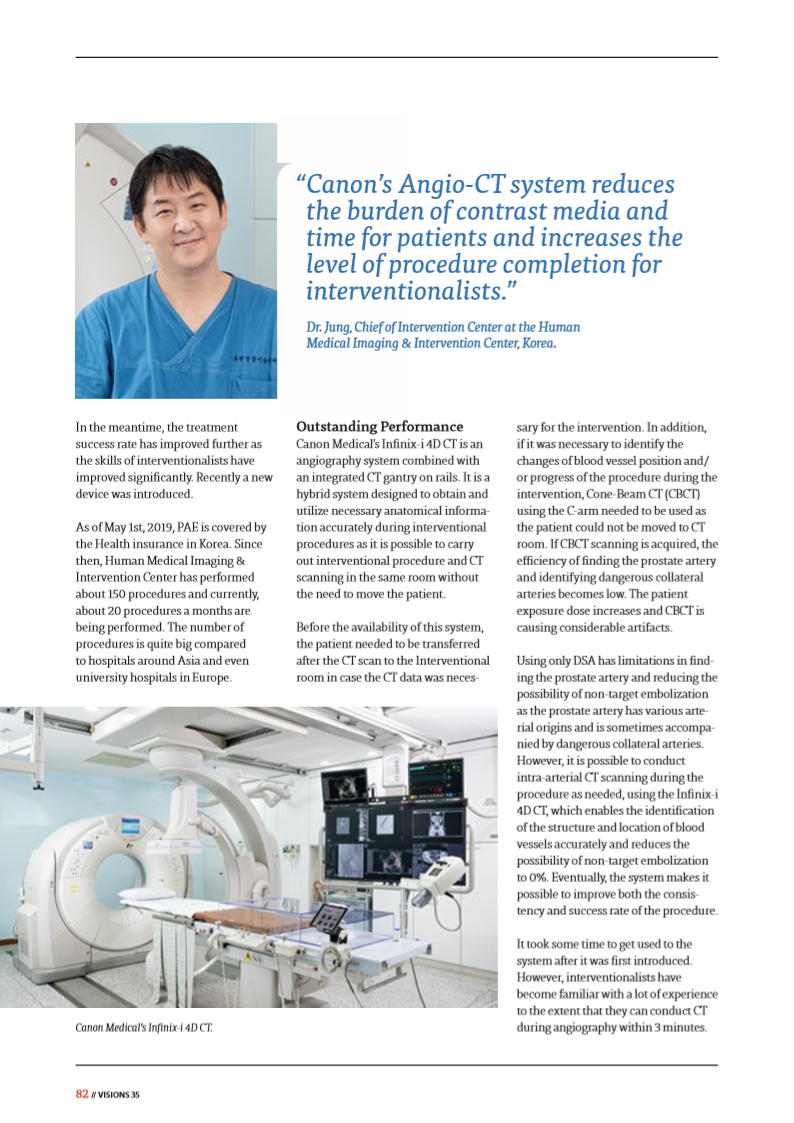
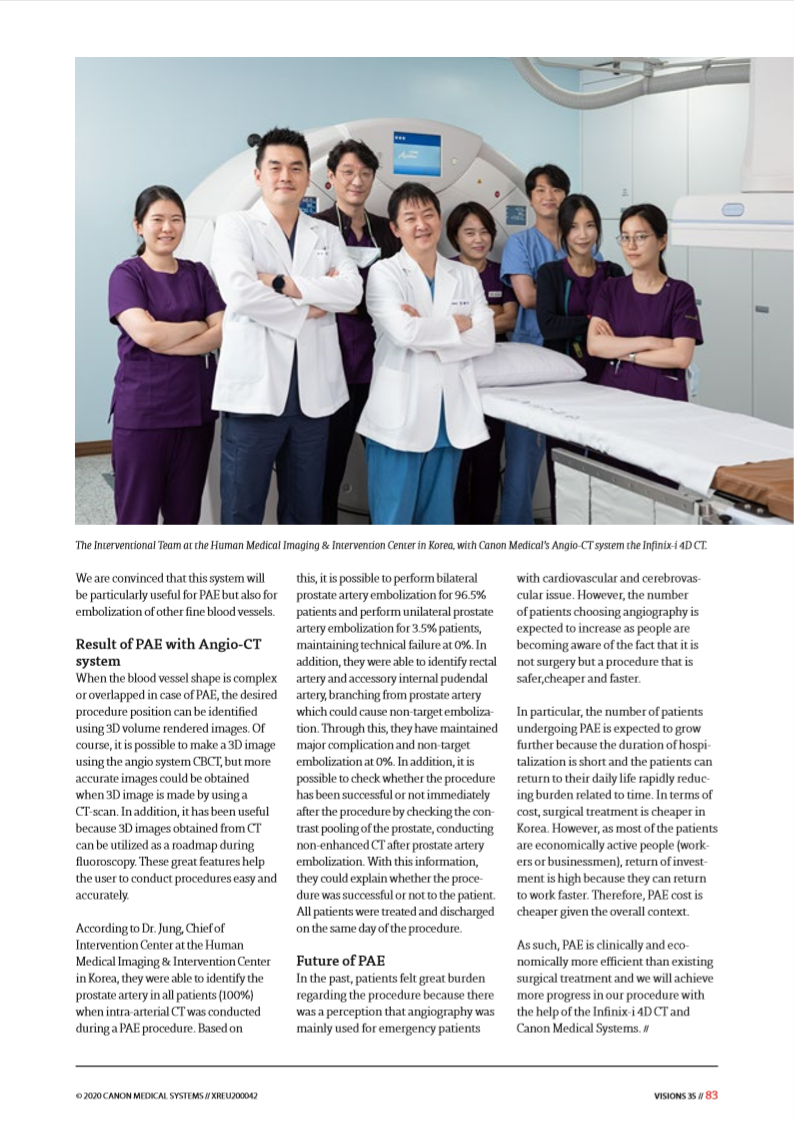
INTERVIEW // INTERVENTIONAL X-RAY // Infinix-i 4D CT, PAE, CBCT
VISIONS spoke with Dr. Jung from the Human Medical Imaging & Intervention Center about their experiences with Canon Medical’s Angio-CT system the Infinix-i 4D CT.
The Largest Radiology Center in Korea Increases the Success Rate of Prostate Artery Embolization (PAE)
Human Medical Imaging & Intervention Center is the largest radiology center in Korea that covers various intervention care from prostatic hyperplasia, uterine myoma, varicose vein and dialysis access to medical checkup and professional clinic.
About 150 radiologists work at Human Medical Imaging & Intervention Center and more than 5 million diagnoses have been made and about 5,000 procedures have been conducted for the past 10 years.
Background of Prostate Artery Embolization
Prostate Artery Embolization (PAE) has been first performed in 2000 for a patient with a prostate size of about 300cc who complained of persistent hematuria. Clinical studies started based on the findings that the prostate size decreased by 40% and the lower urinary tract symptoms have been improved after the procedure. According to the “Results of 10-year Observational Research” published recently, the procedure is clinically effective for about 89% of patients in short-term and about 78% patients in long-term.
There are many reasons behind the increase for PAE. First, the number of patients complaining about prostatic hypertrophy has increased with the increasing number of elderly patients. However, patients were less willing to seek for a treatment due to postoperative sequelae, long recovery period and concerns about the treatment in a sensitive area. PAE is recently grabbing the
attention as it has few complications and fast recovery unlike surgery. In fact, patients feel less time pressure as hospitalization, treatment and discharge from the hospital can be done on the same day.
“Canon’s Angio-CT system reduces the burden of contrast media and time for patients and increases the level of procedure completion for interventionalists.”
Dr. Jung, Chief of Intervention Center at the Human Medical Imaging & Intervention Center, Korea.
In the meantime, the treatment success rate has improved further as the skills of interventionalists have improved significantly. Recently a new device was introduced.
As of May 1st, 2019, PAE is covered by the Health insurance in Korea. Since then, Human Medical Imaging & Intervention Center has performed about 150 procedures and currently, about 20 procedures a months are being performed. The number of procedures is quite big compared to hospitals around Asia and even university hospitals in Europe.
Outstanding Performance
Canon Medical’s Infinix-i 4D CT is an angiography system combined with an integrated CT gantry on rails. It is a hybrid system designed to obtain and utilize necessary anatomical information accurately during interventional procedures as it is possible to carry out interventional procedure and CT scanning in the same room without the need to move the patient.
Before the availability of this system, the patient needed to be transferred after the CT scan to the Interventional room in case the CT data was necessary for the intervention. In addition, if it was necessary to identify the changes of blood vessel position and/
or progress of the procedure during the intervention, Cone-Beam CT (CBCT) using the C-arm needed to be used as the patient could not be moved to CT room. If CBCT scanning is acquired, the efficiency of finding the prostate artery and identifying dangerous collateral arteries becomes low. The patient exposure dose increases and CBCT is causing considerable artifacts.
Using only DSA has limitations in find- ing the prostate artery and reducing the possibility of non-target embolization as the prostate artery has various arterial origins and is sometimes accompa- nied by dangerous collateral arteries.
However, it is possible to conduct intra-arterial CT scanning during the procedure as needed, using the Infinix-i 4D CT, which enables the identification of the structure and location of blood vessels accurately and reduces the possibility of non-target embolization to 0%. Eventually, the system makes it possible to improve both the consis- tency and success rate of the procedure.
It took some time to get used to the system after it was first introduced. However, interventionalists have become familiar with a lot of experience to the extent that they can conduct CT during angiography within 3 minutes. We are convinced that this system will be particularly useful for PAE but also for embolization of other fine blood vessels.
Result of PAE with Angio-CT system
When the blood vessel shape is complex or overlapped in case of PAE, the desired procedure position can be identified using 3D volume rendered images. Of course, it is possible to make a 3D image using the angio system CBCT, but more accurate images could be obtained when 3D image is made by using a CT-scan. In addition, it has been useful because 3D images obtained from CT can be utilized as a roadmap during fluoroscopy. These great features help the user to conduct procedures easy and accurately.
According to Dr. Jung, Chief of Intervention Center at the Human Medical Imaging & Intervention Center in Korea, they were able to identify the prostate artery in all patients (100%) when intra-arterial CT was conducted during a PAE procedure. Based on this, it is possible to perform bilateral prostate artery embolization for 96.5% patients and perform unilateral prostate artery embolization for 3.5% patients, maintaining technical failure at 0%. In addition, they were able to identify rectal artery and accessory internal pudendal artery, branching from prostate artery which could cause non-target embolization. Through this, they have maintained major complication and non-target embolization at 0%. In addition, it is possible to check whether the procedure has been successful or not immediately after the procedure by checking the con- trast pooling of the prostate, conducting non-enhanced CT after prostate artery embolization. With this information, they could explain whether the proce- dure was successful or not to the patient. All patients were treated and discharged on the same day of the procedure.
Future of PAE
In the past, patients felt great burden regarding the procedure because there was a perception that angiography was mainly used for emergency patients with cardiovascular and cerebrovas- cular issue. However, the number of patients choosing angiography is expected to increase as people are becoming aware of the fact that it is not surgery but a procedure that is safer,cheaper and faster.
In particular, the number of patients undergoing PAE is expected to grow further because the duration of hospitalization is short and the patients can return to their daily life rapidly reducing burden related to time. In terms of cost, surgical treatment is cheaper in Korea. However, as most of the patients are economically active people (workers or businessmen), return of investment is high because they can return to work faster. Therefore, PAE cost is cheaper given the overall context.
As such, PAE is clinically and economically more efficient than existing surgical treatment and we will achieve more progress in our procedure with the help of the Infinix-i 4D CT and Canon Medical Systems. //
| 다음글 | 215 | 대한인터벤션영상의학회 전립선동맥색전술 성공 케이스 (보건뉴스 외 다수) | 2,035 |
| 이전글 | 210 | 전립선비대증 비수술, 전립선동맥색전술 (헬스조선) | 2,458 |